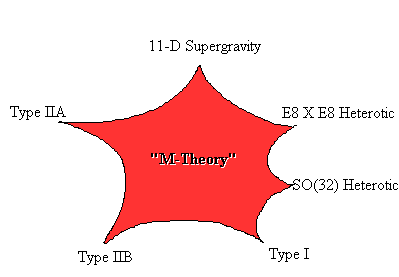A Bit of Physics History: Ed Witten Introduces M-Theory
The Second Superstring Revolution was, like most revolutions, a somewhat messy affair, with a number of pivotal steps along the way: understanding the role of membranes in 11-dimensional supergravity, the discovery of dualities in supersymmetric gauge theories, Polchinski’s appreciation of D-branes as dynamical extended objects in string theory, and of course Maldacena’s formulation of the AdS/CFT correspondence. But perhaps the high point was Ed Witten’s formulation of M-Theory in 1995. And I just noticed that Witten sharing it with the world was captured on video.
Here is Witten’s paper:
String Theory Dynamics In Various Dimensions
Edward WittenThe strong coupling dynamics of string theories in dimension d≥4 are studied. It is argued, among other things, that eleven-dimensional supergravity arises as a low energy limit of the ten-dimensional Type IIA superstring, and that a recently conjectured duality between the heterotic string and Type IIA superstrings controls the strong coupling dynamics of the heterotic string in five, six, and seven dimensions and implies S duality for both heterotic and Type II strings.
Before this result, we knew about five different kinds of string theory, each living in ten dimensions: Type I, two different Type II’s, and two different “heterotic” theories. Then there was the most symmetric form of supergravity, living in 11 dimensions, which some people thought was interesting but others thought was a curiosity that had been superseded by string theory. To everyone’s amazement, Witten showed that all of these theories are simply different limiting cases of a single underlying structure. Nobody knows what that underlying theory really is (although there are a few different formulations that work in some contexts), but we know what to call it: M-theory.
Now Amanda Gefter, author of the new book Trespassing on Einstein’s Lawn (and a recent guest-blogger at Cocktail Party Physics), takes to Twitter to point out something I wasn’t aware of: a video record of Witten’s famous 1995 talk at USC. (I’m pretty sure this is the celebrated talk, but my confidence isn’t 100%.) [Update: folks who should know are actually saying it might be a seminar soon thereafter at Stony Brook. Witten himself admits that he’s not sure.] It’s clearly a recording by someone in the audience, but I don’t know who.
Most physics seminars are, shall we say, not all that historically exciting. But this one was recognized right away as something special. I was a postdoc at MIT at the time, and not in the audience myself, but I remember distinctly how the people who were there were buzzing about it when they returned home.
Nature giveth, and Nature taketh away. The 1995 discovery of M-theory made string theory seem more promising than ever, to the extent that just a single theory, rather than five or six. Then the 1998 discovery that the universe is accelerating made people take more seriously the idea that there might be more than one way to compactify those extra dimensions down to the four we observe — and once you have more than one, you sadly end up with a preposterously high number (the string theory landscape). So even if there is only one unifying theory of everything, there seem to be a bajillion phases it can be in, which creates an enormous difficulty in trying to relate M-theory to reality. But we won’t know unless we try, will we?
A Bit of Physics History: Ed Witten Introduces M-Theory Read More »
